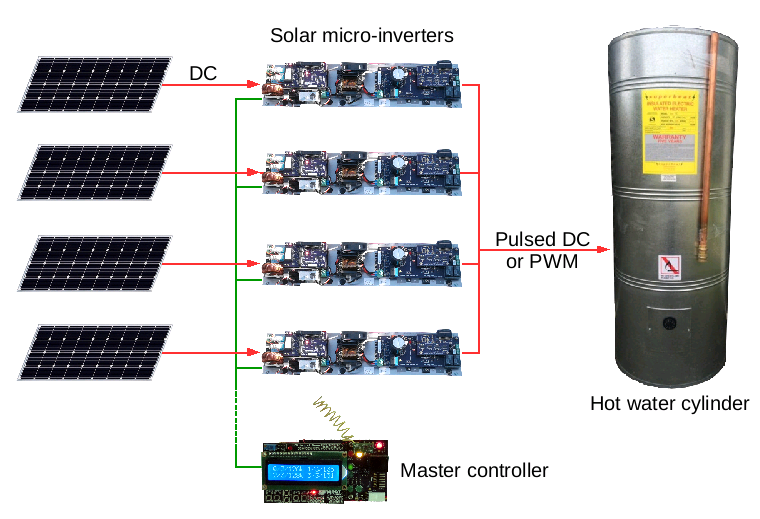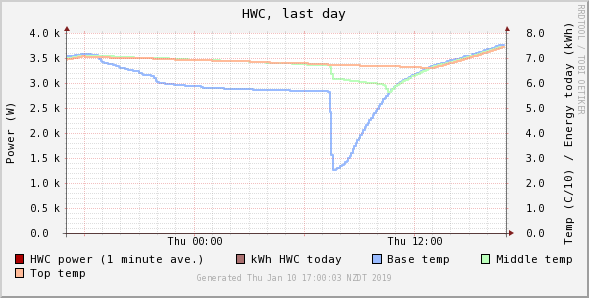The open source solar micro-inverter
The micro-inverter works by taking the low voltage DC produced by a PV panel and creating a high voltage pulsed DC output. Outputs from multiple micro-inverters are combined together and used to drive the load, which in this case is the standard electric element of a hot water cylinder.

The DC at the input to each inverter comes from a single panel (or perhaps pair of panels) and is considered low voltage. This offers improved safety when working on the DC side of the system.
The output from the inverter is high voltage (~325V) pulsed DC and needs to be treated with similar care to a household AC circuit. Another way of thinking of the pulsed output is a PWM output with 100Hz frequency. The width of the pulse is varied according to the amount of power being generated by the PV panel. The pulse width never exceeds 50% thereby providing significant dead time during which the voltage is zero. It is this dead time that makes a pulsed DC system significantly safer than a DC system. Pulsed DC output is perfectly fine for driving a heating element.
The present inverter design is capable of 400W output. The example above shows four such units running in parallel for a combined maximum output of 1.6kW.
The timing of the pulsed DC output from each inverter is synchronised by a master controller unit located inside the dwelling. The synchronisation results in a steady 100Hz output and ensures dead time. The master controller contains an LCD display and keypad allowing the user to monitor the output from the system.
In the hot water cylinder used for the prototype there are three temperature sensors located at the base, middle and top of the tank. These have been used to measure the effect of temperature stratification as well as to get a better idea of how the solar system performs as a whole. Here is a graph showing the temperature of the various sensors during the course of a sunny day.

The large drop in temperature at the base of the tank around 7:30am is due to use of the shower. As hot water at around 70C is drawn off the top of the tank (top temperature is shown in orange), cold water straight from the water mains flows in the bottom (bottom temperature shown in blue). This causes the temperature at the base of the tank to plummet to around 25C. The electric element powered by the solar system is located at the base of the tank and during the day as the solar system heats the water we see the base temperature begin to rise. This graph shows the pronounced effect of stratification in that the base, middle and top of the tank contain water at significantly different temperatures; there is little mixing.
Notice what happens as the temperature at the base reaches the temperature at the middle of the tank around 11am. The water is now mixing significantly and the temperature at the base and the middle of the tank then start to rise in unism. At aroudn 12:30 as the water continues to heat, the water in the base and middle of the tank reach the temperature of the water at the top of the tank. Now any heating applied to water at the base of the tank will cause a uniform rise in temperature in the entire tank. Notice also the slope of the rise in temperature which gives a rough indication of the amount of water being heated. First thing in the morning a small volume in the lower part of the tank which will rise quickly in temperature, then later in the day the entire tank volume (270L) which will rise much more slowly.
Want to know more? Have a look at the gorey details.
Feedback on the best way to start a public discussion would be much appreciated!
Do you have have the need for a big 48V power supply? Check these out - supply 1, supply 2. To give away to a good home. Pick-up only, from Christchurch, New Zealand. Suit DIY electronics enthusiast. Drop me an E-Mail (see below for address).
-Martin van den Nieuwelaar
This page is covered by the GNU Free Documentation License
Martin van den Nieuwelaar, martin at gadgets dot co dot nz
Last updated 12 May 2019
